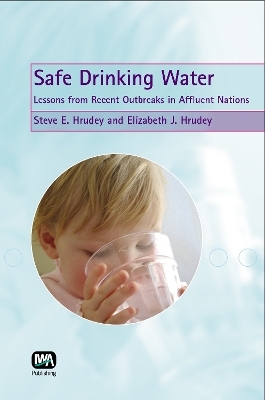
Safe Drinking Water
Seiten
2004
IWA Publishing (Verlag)
978-1-84339-042-8 (ISBN)
IWA Publishing (Verlag)
978-1-84339-042-8 (ISBN)
"Safe Drinking Water" aims to raise understanding and awareness of those factors that have most commonly contributed to or caused drinking-water-transmitted disease outbreaks - essentially a case-history analysis within the multi-barrier framework.
Drinking water provides an efficient source for the spread of gastrointestinal microbial pathogens capable of causing serious human disease. The massive death toll and burden of disease worldwide caused by unsafe drinking water is a compelling reason to value the privilege of having safe drinking water delivered to individual homes. On rare occasions, that privilege has been undermined in affluent nations by waterborne disease outbreaks traced to the water supply. Using the rich and detailed perspectives offered by the evidence and reports from the Canadian public inquiries into the Walkerton (2000) and North Battleford (2001) outbreaks to develop templates for understanding their key dimensions, over 60 waterborne outbreaks from 15 affluent countries over the past 30 years are explored as individual case studies. Recurring themes and patterns are revealed and the critical human dimensions are highlighted suggesting insights for more effective and more individualized preventive strategies, personnel training, management, and regulatory control. Safe Drinking Water aims to raise understanding and awareness of those factors that have most commonly contributed to or caused drinking-water-transmitted disease outbreaks - essentially a case-history analysis within the multi-barrier framework. It contains detailed analysis of the failures underlying drinking-water-transmitted disease epidemics that have been documented in the open literature, by public inquiry, in investigation reports, in surveillance databases and other reliable information sources. The book adopts a theme of 'converting hindsight into foresight', to inform drinking-water and health professionals including operators, managers, engineers, chemists and microbiologists, regulators, as well as undergraduates and graduates at specialty level. Key Features: Contains details and perspectives of major outbreaks not widely known or understood beyond those directly involved in the investigations. Technical and scientific background associated with case studies is offered in an accessible summary form. Does not require specialist training or experience to comprehend the details of the numerous outbreaks reviewed. By providing a broad-spectrum review using a consistent approach, several key recurring themes are revealed that offer insights for developing localized, tailor-made prevention strategies.
Drinking water provides an efficient source for the spread of gastrointestinal microbial pathogens capable of causing serious human disease. The massive death toll and burden of disease worldwide caused by unsafe drinking water is a compelling reason to value the privilege of having safe drinking water delivered to individual homes. On rare occasions, that privilege has been undermined in affluent nations by waterborne disease outbreaks traced to the water supply. Using the rich and detailed perspectives offered by the evidence and reports from the Canadian public inquiries into the Walkerton (2000) and North Battleford (2001) outbreaks to develop templates for understanding their key dimensions, over 60 waterborne outbreaks from 15 affluent countries over the past 30 years are explored as individual case studies. Recurring themes and patterns are revealed and the critical human dimensions are highlighted suggesting insights for more effective and more individualized preventive strategies, personnel training, management, and regulatory control. Safe Drinking Water aims to raise understanding and awareness of those factors that have most commonly contributed to or caused drinking-water-transmitted disease outbreaks - essentially a case-history analysis within the multi-barrier framework. It contains detailed analysis of the failures underlying drinking-water-transmitted disease epidemics that have been documented in the open literature, by public inquiry, in investigation reports, in surveillance databases and other reliable information sources. The book adopts a theme of 'converting hindsight into foresight', to inform drinking-water and health professionals including operators, managers, engineers, chemists and microbiologists, regulators, as well as undergraduates and graduates at specialty level. Key Features: Contains details and perspectives of major outbreaks not widely known or understood beyond those directly involved in the investigations. Technical and scientific background associated with case studies is offered in an accessible summary form. Does not require specialist training or experience to comprehend the details of the numerous outbreaks reviewed. By providing a broad-spectrum review using a consistent approach, several key recurring themes are revealed that offer insights for developing localized, tailor-made prevention strategies.
| Verlagsort | London |
|---|---|
| Sprache | englisch |
| Maße | 156 x 234 mm |
| Themenwelt | Studium ► Querschnittsbereiche ► Epidemiologie / Med. Biometrie |
| Naturwissenschaften ► Biologie ► Mikrobiologie / Immunologie | |
| Technik ► Umwelttechnik / Biotechnologie | |
| ISBN-10 | 1-84339-042-6 / 1843390426 |
| ISBN-13 | 978-1-84339-042-8 / 9781843390428 |
| Zustand | Neuware |
| Haben Sie eine Frage zum Produkt? |
Mehr entdecken
aus dem Bereich
aus dem Bereich
ein überfälliges Gespräch zu einer Pandemie, die nicht die letzte …
Buch | Hardcover (2024)
Ullstein Buchverlage
CHF 34,95


